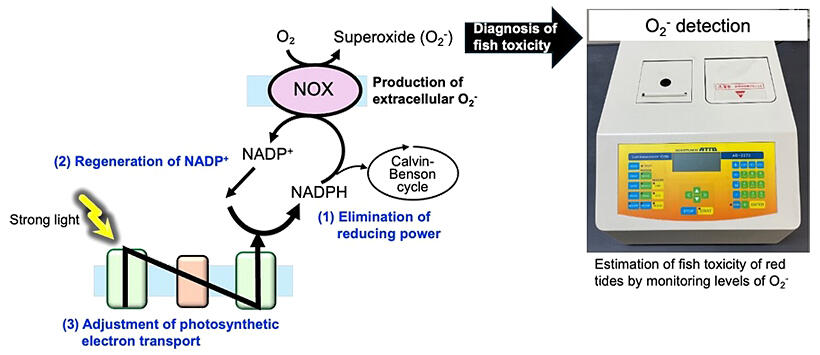A research group led by Professor Yoshitaka Nishiyama of the Graduate School of Science and Engineering at Saitama University, in collaboration with the Fisheries Technology Institute of the Japan Fisheries Research and Education Agency, has announced their research results revealing that the mechanism by which Chattonella marina complex (hereinafter, "Chattonella"), harmful red-tide-forming plankton with high toxicity to fish, protects its ability of photosynthesis from strong light involves the release of large amounts of reactive oxygen species (ROS), which may be responsible for toxicity to fish. The production of the superoxide anion, one of the ROS, is highly correlated with toxicity to fish. ROS production was beneficial for Chattonella in terms of maintaining the capacity for photosynthesis and eliminating competitors. The findings are expected to contribute to developing technologies for predicting red tide damage and other purposes. The results were published in the international journal Harmful Algae on September 13.

Provided by Saitama University
Frequent red tides occur mainly in summer in western Japan and cause extensive damage to the marine product and aquaculture industries. Chattonella, a typical harmful red-tide-forming plankton, is known to extracellularly release large amounts of the superoxide anion, a reactive oxygen species, but the underlying reason and mechanism remained unclear.
In this study, the research group extracted a membrane fraction containing an NADPH oxidase (NOX) from Chattonella and examined the production of superoxide anion. The results showed that the superoxide anion was produced in an NADPH-dependent manner. They also confirmed that the production of superoxide anion was reduced in the presence of a specific inhibitor of NOX.
To investigate the detailed mechanism, they compared a high-toxicity strain with high toxicity to fish and a low-toxicity strain with low toxicity to fish. The high-toxicity strain produced a large amount of the superoxide anion, while the low-toxicity strain produced less than one hundredth, showing a high correlation between the superoxide anion production and toxicity to fish. Furthermore, the low-toxicity strain grew faster than the highly toxic strain, and the difference was attributed to the different capacities for photosynthesis.
Photosynthesis involves photochemical reactions, which convert light energy into NADPH and ATP, and carbon dioxide fixation reactions, which convert carbon dioxide into carbohydrates using NADPH and ATP. The activity of carbon dioxide fixation in the low-toxicity strain was higher than that in the highly toxic strain.
The group suppressed carbon dioxide fixation in the low-toxicity strain with an inhibitor and showed that the production of the superoxide anion doubled. The data suggested that NADPH might be used to produce the superoxide anion. Therefore, the high-toxicity strain of Chattonella was considered to release large amounts of the superoxide anion at the expense of the capacity for carbon dioxide fixation through photosynthesis. Furthermore, inhibition of photosynthetic carbon dioxide fixation resulted in a decrease in the amount of NADP+, the oxidized form of NADPH, only in the low-toxicity strain. A decrease in NADP+ occurs under strong light and leads to a marked decrease in photosynthetic activity. These data suggest that Chattonella promotes regeneration of NADP+ through the production of the superoxide anion as a bypass pathway, maintaining smooth photosynthesis even under strong light.
The production of superoxide anion was found to consume and extracellularly release the excess reducing power generated through photosynthesis. The amount of the superoxide anion released by Chattonella is enough to exert bactericidal effects, serving as a defense mechanism against foreign enemies. In addition, protecting the capacity for photosynthesis from strong light is considered an important strategy of Chattonella for the dominant proliferation in the surface layer of the sea, where various phytoplankton species compete.
Nishiyama said, "Why do farmed fish die when red tide occurs? The underlying mechanism remains to be clarified. Chattonella, a harmful red-tide-forming plankton causing the largest damage to fisheries in Japan, extracellularly releases large amounts of ROS, which have a strong correlation with toxicity to fish. We have found that the release of ROS is closely related to photosynthesis. This discovery is considered a step toward a full understanding of mechanisms for toxicity of Chattonella to fish."
Journal Information
Publication: Harmful Algae
Title: Production of extracellular superoxide contributes to photosynthesis via elimination of reducing power and regeneration of NADP+ in the red-tide-forming raphidophyte Chattonella marina complex
DOI: 10.1016/j.hal.2024.102712
This article has been translated by JST with permission from The Science News Ltd. (https://sci-news.co.jp/). Unauthorized reproduction of the article and photographs is prohibited.




